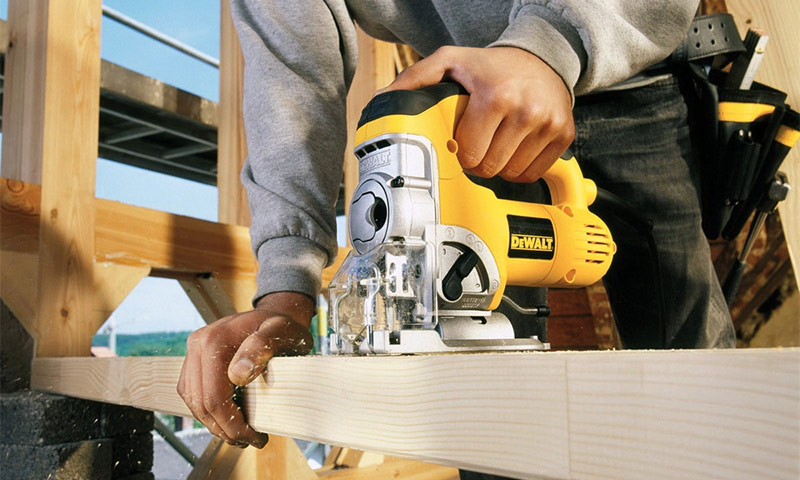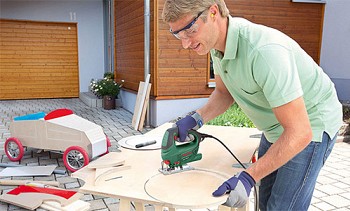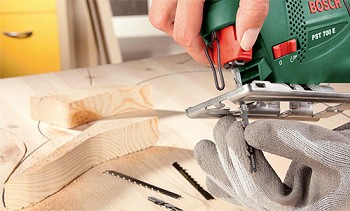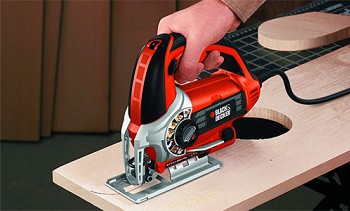In this material we will tell you how to use an electric jigsaw, how to properly cut various materials and saw out curly elements. You will learn about the safety rules when working with the tool, the intricacies of its maintenance, frequent breakdowns and ways to avoid them.

Content:
- Preparation of the tool for work and additional devices
- How to cut a tree
- How to saw chipboard, laminate
- How to cut metal
- How to cut plastic
- How to cut tiles
- Features of cutting round and oval elements
- Features of cutting straight elements
- Features of angle sawing
- Sawing with a saw table
- The most frequent breakdowns, how to avoid them and safety
- Video: Choosing and working with a jigsaw
Preparation of the tool for work and additional devices
Jigsaw is a kind of universal device, which in some cases can replace a number of tools. Before starting work, it is necessary to carry out an external inspection of the tool: make sure the integrity of the power cable, check the connection to the mains.
It is also important to choose the right blade - for each material undergoing sawing, its own requirements. The markings applied to the material should be clear and clearly visible. You can use the laser guide, if one is included with the jigsaw. However, experienced craftsmen, for a more accurate cut, are advised to focus on the marks applied to the sole. All work is best done on the saw table - this item can be purchased at the store, or arrange it yourself.
A number of manufacturers produce accessories to help them perform various operations. The following additional devices will be of good help:
#1. A parallel emphasis compass - is useful for cutting circles.
#2. Parallel emphasis - for a straight cut.
#3. Guide rail - simplifies straight line cutting.

#4. Detachable pad for the support block - can be made of plastic or metal and is used to increase the sliding of the jigsaw on the surface of the processed material.

#5. Splinterproof liner - used to reduce the likelihood of chips in the process, especially relevant when sawing laminated lumber.

Having studied how to use the jigsaw properly, you can proceed directly to the cut. The choice of the file and the operating mode plays a rather important role in the process of sawing the material and operating the tool. If the operating mode is incorrectly selected, the jigsaw may break. Therefore, do not neglect the recommendations described below.
How to cut a tree
File selection. Sawing of wood is carried out by standard saws with upward-facing teeth of medium size with a pitch of cloves from 2.5 to 4 mm. The length of the file is selected in accordance with the thickness of the workpiece.

Stroke frequency. The stroke frequency is set to the maximum. This indicator should be reduced only if the canvas is prone to overheating, or discomfort is felt during operation.
Pendulum stroke. To increase the cutting speed, it is necessary to turn on the swingarm. It negatively affects the quality of cut, so you need to use it when fast work is important, and the quality of cut is not particularly important.
Sawing process. Work should be on the back of the material to avoid damage to the product. Before sawing the workpiece must be marked.When sawing, the tool must be pressed evenly to the surface and smoothly guided. It is not necessary to push it strongly forward, because as it cuts, it moves forward in the material, especially when the pendulum mechanism is on.

How to saw chipboard, laminate
Next, we will consider how to evenly saw off a chipboard with a jigsaw to avoid damage to the laminated front surface.
File selection. Experts recommend using a reverse cut file. True, in the process of work, a feeling of discomfort due to increased vibration may occur, but the quality of the cut will not suffer. If sawing is carried out with a conventional file, work is carried out on the back of the processed material.

Stroke frequency. The stroke frequency must be set to maximum.
Pendulum mechanism. In order not to form chips, the pendulum mechanism must be turned off.
Sawing process. The tool must be tightly pressed to the surface of the material, while it must be conducted smoothly without strong pressure.

Chips appear exactly on the part of the material that is facing the tool. Therefore, if the cut is made with a file with ordinary teeth, then you can pre-determine the front side of the product to make a cut on the back side.

In addition, a splinterproof insert can be used to make cuts in a chipboard or laminate. This is a small piece with a cut, which is inserted into special guides on the sole. The most ideal insert is one in which the cut exactly matches the thickness of the blade. Therefore, some manufacturers supply several of these inserts complete with a jigsaw. At the same time, it was necessary to do the cut in each of them yourself. Then you can start sawing chipboard.

How to cut metal
File selection. For cutting metal surfaces, small-tooth files are used - tooth pitch 1 - 2 mm. Visually, such a file resembles a hacksaw blade for metal and can be used for cutting other materials in order to increase the purity of cut.

Stroke frequency. Sawing speed must be set as low as possible.
Pendulum mechanism. The pendulum stroke is completely switched off.
Sawing process. The workpiece tool must be moved slowly, without pressure. The tin sheet must be firmly fixed in advance by positioning it so that the cut line is as close as possible to the support.

If it is necessary to make a curved cut in thin tin, and positioning the workpiece so that the cut line is close to the support is not possible, then it must be placed between two sheets of fiberboard or hardboard. All marking is applied to the top sheet of the fiberboard. This will prevent burr formation.

It is also recommended to take short breaks in work and apply additional cooling sources to avoid overheating of the file.
How to cut plastic
File selection. It is better to use a canvas with a small tooth, similar to that for metal. This will improve the overall quality of work.
The jigsaw settings are set individually, depending on the type of plastic.
Pendulum stroke. To obtain an even cut, the pendulum stroke is set to the minimum position or is completely turned off.
Stroke frequency. Speed - no more than 40% of maximum.

How to cut tiles
File selection. To work on this material, a special blade without teeth is used. Abrasive materials are applied to the surface of such files. Cutting tiles or ceramic tiles is rarely used, because the consumption of paintings in this case is too large.

Pendulum stroke. The pendulum stroke is turned off.
Stroke frequency. Work is carried out at the minimum set speed.
An electric jigsaw is ideal for cutting short curved elements in a tile.
Features of cutting round and oval elements
In this section, we will discuss how to properly saw round or oval elements with a jigsaw.First you need to mark the material. In most cases, a hole is drilled in the workpiece from which the product will be cut. The diameter of the drill should slightly exceed the width of the blade. For cutting curved elements, it is necessary to take a narrow file designed for such work.

The jigsaw is displayed slowly on the desired path. If you want to cut a circle of the correct shape, you can use the additional device - a circular cutter. To do this, it is necessary to determine the center of the circle and fix the stop-compass there, to cut out.

For such work, it is better to choose a narrow canvas. In the process of sawing, you need to focus on the position of the blade, because the elements that help with the execution of a straight cut (guiding "flies", lasers), in this case, will only disrupt the direction.
In some cases, you can do without drilling holes in the workpiece. To do this, the tool is installed with the sole edge behind the marking line. The jigsaw turns on, and with careful movements it bends to touch the working surface. The angle increases until the workpiece is cut through and through. After that, the tool stops, the file is removed and installed in the standard operating position. Exit to the marking is carried out by the method of gradual rounding of the cut line. Any effort on the tool should be avoided.

For sawing out non-standard figures or patterns, the jigsaw is installed using special fasteners or a saw table in a stationary state, with the saw up. In this case, it is necessary to wield not with a jigsaw, but with the workpiece itself, moving it in accordance with the markup. This method of cutting provides the maximum overview of the work process, compliance with the cutting line, control over the workpiece. Tool settings are set according to the material being processed.

Features of cutting straight elements
Despite the fact that this type of work is one of the most common, with a lack of experience, difficulties may arise with how to smoothly saw off any element with a jigsaw. It is recommended that you opt for a wide blade file designed for straight cutting to better maintain the marking line. For an even cut, the presence of the “soft start” function plays an important role. The tool in this case begins to gain momentum gradually, due to which the jigsaw is better controlled at the initial stage of cutting.
In the process of work, excessive efforts should not be made to move the jigsaw forward, otherwise this will lead to failure of the file or the mechanisms of the tool. A worn blade should be replaced immediately, because a dull file causes an increased load on the drive. The workpiece to be sawed must be firmly fixed.
To make straight cuts, you can use a parallel stop or a guide rail.
Guide bar sawing
First, the workpiece must be marked. After that? having installed the jigsaw in a special shoe, and then the shoe in the tire, the tool is positioned along the cutting line.

Having installed the tool file exactly along the cutting line, the guide rail is fastened.

The tool is launched and driven along the tire. It depends a little on the operator. Much more on the quality of the cut will be affected by the quality of the file and the jigsaw itself.

There are tires with clamps that allow you to make both straight cuts and cuts at an angle.
Sawing with a parallel stop
A parallel emphasis often comes with a jigsaw, but regardless of this, almost all models have a slot in the sole for attaching a parallel stop rod.

You can make a quality cut with this device only in the following cases:
- The supporting plane along which the shoe will move must be flat and parallel.
- The jigsaw must be of high quality and resistant to pulling to the side.
- The parallel emphasis itself, i.e., its rod and shoe, must be strong and rigid.
- The operator must firmly press the shoe against the supporting surface when moving the tool.
Features of angle sawing
Cutting at an angle can only be performed with tools that support this function. The angle cutting process is ensured by adjusting the base of the jigsaw. Manufacturers often equip their products with several clamps - usually at 15, 30, 45 degrees. A square or protractor can also be of great help in controlling the position of the tool support.

Particular attention should be paid to the selection of files. For most of the work, homogeneous blades are suitable, for sawing at an angle - it is better to use heterogeneous (bimetal). The cost of such files is slightly higher than uniform ones, but they are much stronger and have the ability to bend without breaking.

Sawing with a saw table
The design of the table can greatly simplify the work with a jigsaw, especially when sawing elements of a round, oval or complex shape. You can buy such a table, or make it yourself.
In this case, the operator does not move the tool itself, but the workpiece in which sawing is performed.

Such a machine allows you to better control the workpiece, to comply with the marking line. As with a jigsaw, great effort should be avoided on the workpiece.
The most frequent breakdowns, how to avoid them and safety
It is important not only to know how to saw with a jigsaw, but also to try to avoid causes that could lead to tool breakage.
Electric motor. Most often, in an electric jigsaw, the engine fails. There can be several causes of failure: burnout of the rotor, stator, wear of the notch on the shaft. To avoid rotor burnout, you need to purchase a tool whose power will be enough to perform the required tasks. For example, if you need to cut large workpieces, a 400 W jigsaw will not be enough - the engine simply can not withstand the load and burn out. This can lead to insufficiently high voltage in the network. It is not recommended to set too low revs too often: lack of cooling and high currents can lead to burnout burnout.
A notch on the shaft may wear out due to constant shock loads on the tool rod. Shock loads on the stem appear due to improper selection of equipment. Therefore, always follow the recommendations when selecting a saw blade.
Power button. Sometimes owners of a jigsaw encounter a malfunction of the power button. Pressing the "trigger" leads to circuit closure and engine starting. If metal dust enters the case, the normal operation of the power button may be impaired. To eliminate dust in the process, you can use a special vacuum cleaner (household does not fit). Failure of the "trigger" may result in natural wear of conductive tracks. I must say, this process is quite lengthy.
Mechanics. Among the mechanical components, the stock may be problematic: this part is subjected to serious mechanical stresses arising during the sawing process. The mechanism of web fixation is the weakest in this system, because it is directly connected to the stock. Do not be afraid of damage to the gearbox if the case reliably protects the internal mechanisms of the tool from dust.
Safety and jigsaw maintenance
Basic safety rules must be indicated in the instruction manual. It is strictly forbidden to perform any work while intoxicated. Before starting work, make sure that the tool is in good working order, the presence of goggles and gloves, and the voltage stability of the network.It is necessary to take care in advance of good lighting of the workplace. Work with a jigsaw should be carried out in a dry room. There should not be flammable substances nearby.
At the end of the work, the tool is thoroughly cleaned of dust, if possible, it is blown with air (with the engine running, the purge efficiency will be higher). Lubricant is applied to moving parts as necessary. Store the tool in a dry room. Compliance with these simple recommendations will significantly increase the life of the jigsaw.









